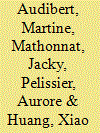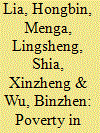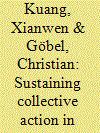|
|
|
Sort Order |
|
|
|
Items / Page
|
|
|
|
|
|
|
| Srl | Item |
| 1 |
ID:
124565


|
|
|
|
|
| Publication |
2013.
|
| Summary/Abstract |
In the rural health-care organization of China, township hospitals ensure the delivery of medical services above village health stations and below county hospitals. Particularly damaged by the economic reforms implemented from 1975 to the end of the 1990s, the efficiency of township hospitals has been questioned, mainly because of the implementation since 2003 of the reform of health insurance in rural areas (New Rural Cooperative Medical Scheme). From a database of 24 randomly selected township hospitals observed over the period 2000-2008 in Weifang Prefecture (Shandong), this study examines the efficiency of township hospitals through a two-stage approach. As curative and preventive medical services delivered at township hospital level use different production processes, two data envelopment analysis models are estimated with different orientations to compute scores. The results show that technical efficiency has declined over time. The factors explaining technical efficiency are mainly environmental characteristics rather than internal ones. Among these environmental factors, NRCMS have in average a negative effect on the evolution of THs efficiency, although efficiency have improved for some of them. Our results suggest also that, in the context of China, the efficiency of township hospitals is influenced by unobservable factors. From our findings, we suggest five main orientations to improve THs efficiency.
|
|
|
|
|
|
|
|
|
|
|
|
|
|
|
|
| 2 |
ID:
124895


|
|
|
|
|
| Publication |
2013.
|
| Summary/Abstract |
We use the Chinese College Student Survey, conducted in 2010, to examine levels of poverty among students on China's campuses. With the poverty line defined as the college-specific expenditures a student needs to maintain a basic living standard on campus, we find that 22 per cent of college students in China are living in poverty. Poverty is more severe among students from rural or western parts of the country. With a targeting count error of more than 50 per cent, it is important that the college need-based aid programme be improved. Lacking other income sources, poor students rely heavily on loans and paid employment to finance their college education.
|
|
|
|
|
|
|
|
|
|
|
|
|
|
|
|
| 3 |
ID:
124890


|
|
|
|
|
| Publication |
2013.
|
| Summary/Abstract |
In recent years there has been a proliferation of scholarship on protests and other forms of collective action in China. Important insights have been gained into how conflicts between social groups and local governments begin, which strategies and instruments protesters apply, and under which circumstances protests are likely to succeed or fail. However, comparatively little is known about the mobilizing structures and how such collective action can be sustained over a long period of time, in some instances over several years. Such perseverance would be remarkable even in a democracy, but it is more so in an authoritarian system where the risks of participating in collective action are higher and the chances to succeed much smaller. This article compares the development of public protests in two research locations and identifies four factors instrumental to overcoming the formidable challenges of sustaining collective action in China: the continuing existence of substantial grievances; the re-activation of strong social ties; the presence of unifying frames; and an adaptive protest leadership. The comparison shows that the last factor is particularly crucial: while the two villages were similar in all other respects, leadership in village B was far more adaptive than in village A, which goes a long way towards explaining why collective action could be sustained twice as long in village B.
|
|
|
|
|
|
|
|
|
|
|
|
|
|
|
|
|
|
|
|
|